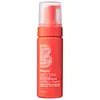What's inside
What's inside
 Key Ingredients
Key Ingredients

 Benefits
Benefits

 Concerns
Concerns

 Ingredients Side-by-side
Ingredients Side-by-side

Water
Skin ConditioningPullulan
Galactoarabinan
Aloe Barbadensis Leaf Juice
Skin ConditioningGlycerin
HumectantCaprylyl/Capryl Glucoside
CleansingGluconolactone
Skin ConditioningSodium Benzoate
MaskingCalcium Gluconate
HumectantHydrolyzed Rice Protein
Skin ConditioningDecyl Glucoside
CleansingLauryl Glucoside
CleansingSorbitol
HumectantPotassium Sorbate
PreservativeCananga Odorata Flower Oil
MaskingLavandula Angustifolia Oil
MaskingCitrus Aurantium Dulcis Peel Oil
MaskingSalvia Sclarea Oil
MaskingVanillin
MaskingPogostemon Cablin Leaf Oil
MaskingGlycine Soja Oil
EmollientHydroxypropyltrimonium Honey
Sorbic Acid
PreservativeCitric Acid
BufferingDiheptyl Succinate
EmollientCapryloyl Glycerin/Sebacic Acid Copolymer
Skin ConditioningVaccinium Macrocarpon Seed Oil
Skin ConditioningVitis Vinifera Seed Oil
EmollientCucurbita Pepo Seed Oil
EmollientMacadamia Ternifolia Seed Oil
EmollientMacelignan
AntimicrobialTocopherol
AntioxidantLinalool
PerfumingLimonene
PerfumingWater, Pullulan, Galactoarabinan, Aloe Barbadensis Leaf Juice, Glycerin, Caprylyl/Capryl Glucoside, Gluconolactone, Sodium Benzoate, Calcium Gluconate, Hydrolyzed Rice Protein, Decyl Glucoside, Lauryl Glucoside, Sorbitol, Potassium Sorbate, Cananga Odorata Flower Oil, Lavandula Angustifolia Oil, Citrus Aurantium Dulcis Peel Oil, Salvia Sclarea Oil, Vanillin, Pogostemon Cablin Leaf Oil, Glycine Soja Oil, Hydroxypropyltrimonium Honey, Sorbic Acid, Citric Acid, Diheptyl Succinate, Capryloyl Glycerin/Sebacic Acid Copolymer, Vaccinium Macrocarpon Seed Oil, Vitis Vinifera Seed Oil, Cucurbita Pepo Seed Oil, Macadamia Ternifolia Seed Oil, Macelignan, Tocopherol, Linalool, Limonene
Water
Skin ConditioningDecyl Glucoside
CleansingGlycerin
HumectantVp/Va Copolymer
Pullulan
Prunus Domestica Seed Oil
Skin ConditioningSqualane
EmollientNiacinamide
SmoothingBiotin
AntiseborrhoeicFolic Acid
Skin ConditioningPolyglyceryl-3 Cocoate
EmulsifyingPolyglyceryl-4 Caprate
EmulsifyingHydrogenated Lecithin
EmulsifyingHelianthus Annuus Seed Oil
EmollientPolyglyceryl-6 Caprylate
EmulsifyingPolyglyceryl-6 Ricinoleate
EmulsifyingSodium Polyitaconate
Sucrose
HumectantCitric Acid
BufferingPanthenol
Skin ConditioningSodium Starch Octenylsuccinate
AbsorbentCalcium Pantothenate
Maltodextrin
AbsorbentSodium Ascorbyl Phosphate
AntioxidantPyridoxine Hcl
Skin ConditioningTocopheryl Acetate
AntioxidantCitrus Junos Peel Extract
Skin ConditioningSilica
AbrasiveParfum
MaskingDehydroacetic Acid
PreservativeBenzyl Alcohol
PerfumingWater, Decyl Glucoside, Glycerin, Vp/Va Copolymer, Pullulan, Prunus Domestica Seed Oil, Squalane, Niacinamide, Biotin, Folic Acid, Polyglyceryl-3 Cocoate, Polyglyceryl-4 Caprate, Hydrogenated Lecithin, Helianthus Annuus Seed Oil, Polyglyceryl-6 Caprylate, Polyglyceryl-6 Ricinoleate, Sodium Polyitaconate, Sucrose, Citric Acid, Panthenol, Sodium Starch Octenylsuccinate, Calcium Pantothenate, Maltodextrin, Sodium Ascorbyl Phosphate, Pyridoxine Hcl, Tocopheryl Acetate, Citrus Junos Peel Extract, Silica, Parfum, Dehydroacetic Acid, Benzyl Alcohol
Alternatives
Ingredients Explained
These ingredients are found in both products.
Ingredients higher up in an ingredient list are typically present in a larger amount.
Citric Acid is an alpha hydroxy acid (AHA) naturally found in citrus fruits like oranges, lemons, and limes.
Like other AHAs, citric acid can exfoliate skin by breaking down the bonds that hold dead skin cells together. This helps reveal smoother and brighter skin underneath.
However, this exfoliating effect only happens at high concentrations (20%) which can be hard to find in cosmetic products.
Due to this, citric acid is usually included in small amounts as a pH adjuster. This helps keep products slightly more acidic and compatible with skin's natural pH.
In skincare formulas, citric acid can:
While it can provide some skin benefits, research shows lactic acid and glycolic acid are generally more effective and less irritating exfoliants.
Most citric acid used in skincare today is made by fermenting sugars (usually from molasses). This synthetic version is identical to the natural citrus form but easier to stabilize and use in formulations.
Read more about some other popular AHA's here:
Learn more about Citric AcidDecyl Glucoside is a glucose-based surfactant and emulsion stabilizer. It is created by reacting glucose with the fatty acids from plants.
Surfactants help clean the skin by trapping oil, sebum, and dirt to be washed away. As an emulsion stabilizer, it stabilizes the ingredients in a product by preventing them from separating.
This ingredient is biodegradable and non-toxic. This ingredient is commonly found in baby shampoos.
Decyl Glucoside is sometimes used to stabilize the UV filter Tinosorb.
Learn more about Decyl GlucosideGlycerin is already naturally found in your skin. It helps moisturize and protect your skin.
A study from 2016 found glycerin to be more effective as a humectant than AHAs and hyaluronic acid.
As a humectant, it helps the skin stay hydrated by pulling moisture to your skin. The low molecular weight of glycerin allows it to pull moisture into the deeper layers of your skin.
Hydrated skin improves your skin barrier; Your skin barrier helps protect against irritants and bacteria.
Glycerin has also been found to have antimicrobial and antiviral properties. Due to these properties, glycerin is often used in wound and burn treatments.
In cosmetics, glycerin is usually derived from plants such as soybean or palm. However, it can also be sourced from animals, such as tallow or animal fat.
This ingredient is organic, colorless, odorless, and non-toxic.
Glycerin is the name for this ingredient in American English. British English uses Glycerol/Glycerine.
Learn more about GlycerinPullulan is a low viscosity polysaccharide (a long chain carbohydrate) with binding and film forming properties when dissolved in water. It is used to create a "silicone-like" or silky feel in cosmetics without adding viscosity.
According to a manufacturer, this ingredient's ability to easily dissolves makes it a great carrier for active ingredients.
Due to it being edible and tasteless, you'll likely find this ingredient in breath freshener strips. This ingredient is produced from the starch of the fungus, Aureobasidium pullulans.
Pullulan is stable over a broad-range of pH.
Learn more about PullulanWater. It's the most common cosmetic ingredient of all. You'll usually see it at the top of ingredient lists, meaning that it makes up the largest part of the product.
So why is it so popular? Water most often acts as a solvent - this means that it helps dissolve other ingredients into the formulation.
You'll also recognize water as that liquid we all need to stay alive. If you see this, drink a glass of water. Stay hydrated!
Learn more about Water